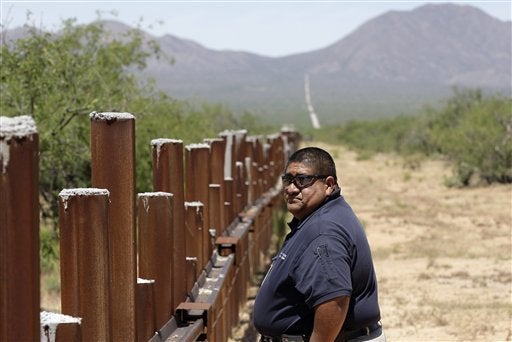
After months of inaction and hundreds of millions in taxpayer money handed over to defense giant Boeing Co., federal officials have chosen to give up on a troubled border surveillance initiative known as the "virtual fence," or SBInet.
Homeland Security Secretary Janet Napolitano pulled $50 million in economic stimulus funds out from under the program last March complaining that SBInet -- first unveiled by her predecessor, Michael Chertoff, during a November 2005 speech in Houston -- had been "plagued with cost overruns and missed deadlines."
She ordered an internal review of the program, but a significant amount of time passed before the Obama administration made any meaningful decisions that spelled the official end of SBInet. Congress was first told the ambitious network of surveillance cameras, radars and sensors would cover the nation's nearly 2,000-mile southwest border with Mexico by 2009.
Operating together, the devices were supposed to alert patrol officers as illegal border crossers attempted to enter the country and dramatically expand the area of land that watchers could effectively secure. Instead, Napolitano conceded in a recent statement that SBInet "does not meet current standards for viability and cost effectiveness."
DHS will reportedly continue to use some portions of the project, such as radar and sensor towers, but as of now the technology covers little more than 50 miles of Arizona's border. SBInet's executive director, Mark Borkowski, told Congress last spring that Boeing had earned about $615 million from SBInet by that time.
Boeing said in a statement referring to DHS, "we appreciate that they recognize the value of the integrated fixed towers Boeing has built, tested and delivered so far," according to the Wall Street Journal. It also said Boeing "remains committed to providing valuable solutions and supporting DHS."
The latest reports, however, do not mean U.S. taxpayers will cease pouring money into high-tech border surveillance, despite years of shaky attempts that began during the Clinton administration with a program called the Integrated Surveillance Intelligence System, or ISIS. Elevated Risk reported in October that the defense mega-contractor Raytheon Co. was already lining up to offer its own presumably pricey alternative.
Raytheon showcased a product similar to SBInet that its calling Clear View at a conference last year attended by thousands of security industry professionals and government officials where Raytheon worked to contrast itself with Boeing. Raytheon lost an earlier bid for the project in 2006.
A newer approach to border surveillance described by Napolitano, meanwhile, could still cost upwards of $750 million to cover the remainder of Arizona's border. When Napolitano announced the removal of Recovery Act dollars from SBInet, she vowed that the tens of millions would instead be used for an array of mobile surveillance equipment, cameras, radios for communicating, laptops and more.
FLIR Systems of Portland, Ore., revealed this month it had received a contract valued at more than $100 million from Customs and Border Protection for new gear, including long-range thermal imaging cameras affixed to vehicle-mounted towers and capable of use day or night.
The federal government has also inked agreements with American Science & Engineering of Massachusetts for dozens of vehicle X-ray scanners that operate similar to airport body imagers by exposing the contents of passing vehicles without requiring a physical search inside, as Elevated Risk reported last September. One of those pacts involves $19 million worth economic stimulus funds.
As for SBInet, members of Congress responsible for overseeing the Department of Homeland Security seized on the latest development releasing a flurry of press statements. Connecticut Independent Joe Lieberman of the Senate Homeland Security and Governmental Affairs Committee said SBInet's "one-size-fits-all approach was unrealistic."
Democrat Bennie Thompson of Mississippi, former chair of the House Homeland Security Committee, called the program "a grave and expensive disappointment from its inception."
New York's Peter King, a Republican who recently took Thompson's committee chair, said he understood the decision to shut down SBInet, but he also condemned Obama's "lack of urgency to secure the border."
News first surfaced in October that DHS would not continue its contract with Boeing and that SBInet could ultimately be halted altogether.
A string of negative reviews from congressional investigators at the Government Accountability Office and the Department of Homeland Security's watchdog inspector general have haunted SBInet throughout its lifetime. An October report from the GAO said poor contractor oversight was a "major contributor to the program's well-chronicled history of not delivering promised system capabilities on time and on budget."
G.W. Schulz joined the Center for Investigative Reporting in 2008 to launch its ongoing homeland security project. Read the project's blog, Elevated Risk, here.